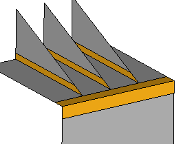Cross Extend Surfaces
Use the Surfaces: Cross Extend tool to extend surfaces to meet each other, or other target surfaces.
View new features for Altair HyperWorks 2023.
Learn the basics and discover the workspace.
Learn more about the Altair HyperWorks suite of products with interactive tutorials.
Start and configure the applications.
View a list of deprecated panels and their newer, equivalent workflows.
Create, open, import, and save models.
Set up sessions and create report templates.
Solver interfaces supported in HyperMesh.
A solver interface is made up of a template and a FE-input reader.
Browsers provide a structured view of model data, which you can use to review, modify, create, and manage the contents of a model. In addition to visualization, browsers offer features like search, filtering, and sorting, which enhance your ability to navigate and interact with the model data.
Create and edit 2D parametric sketch geometry.
Create, edit, and cleanup geometry.
FE geometry is topology on top of mesh, meaning CAD and mesh exist as a single entity. The purpose of FE geometry is to add vertices, edges, surfaces, and solids on FE models which have no CAD geometry.
Explore the different types of mesh you can create in HyperMesh and create and edit 0D, 1D, 2D, and 3D elements.
Define meshing preferences.
Each element has an associated element configuration. An element configuration tells HyperMesh how to draw, store, and work with the element.
Solver cards supported for elements.
Use the Element Quality view to review element quality while simultaneously editing your model.
Explore the different types of 1D mesh you can create in HyperMesh.
Explore the different types of 2D mesh you can create in HyperMesh.
Supported 2D elements.
Explore the tools used to create 2D mesh.
A surface represents the geometry associated with a physical part. A surface is a two-dimensional geometric entity that may be used in automatic mesh generation.
Use the Surfaces: Patch/Spline tool to create patch surfaces or spline surfaces. You can also delete surfaces with this tool.
Use the Surfaces: Extend tool to create tangent or normal extension surfaces.
Use the Surfaces: Cross Extend tool to extend surfaces to meet each other, or other target surfaces.
Use the Surfaces: Skin tool to create a surface by skinning across lines.
Use the Surfaces: From FE tool to create surfaces that closely fit a selection of shell elements.
Use the Imprint tool to imprint geometry or mesh onto target surface/lines or elements creating new edges/fixed points or a mesh patch respectively.
Use the Replicate tool to replicate a mesh from one location to another, with options to keep the original mesh, as well as to replicate into multiple copies. The replicated elements replace the original elements, maintaining relevant information like properties, thicknesses, and other solver attributes.
Explore the tools used to create surface mesh.
Explore the tools used to edit 2D mesh.
Explore the different types of 3D mesh you can create in HyperMesh.
Create, organize and manage parts and subsystems.
HyperMesh composites modeling.
Create connections between parts of your model.
Rapidly change the shape of the FE mesh without severely sacrificing the mesh quality.
Create a reduced ordered model to facilitate optimization at the concept phase.
Workflow to support topology optimization model build and setup.
Setup an Optimization in HyperMesh.
Multi-disciplinary design exploration and optimization tools.
Validate the model built before running solver analysis.
Models require loads and boundary conditions in order to represent the various physics and/or physical equivalents to bench and in-use testing.
Reduce a full 3D model with axisymmetric surfaces while accounting for imperfections.
Tools and workflows that are dedicated to rapidly creating new parts for specific use cases, or amending existing parts. The current capabilities are focused on stiffening parts.
Tools used for crash and safety analysis.
Use airbag folder utilities and export a resulting airbag in a Radioss deck.
Essential utility tools developed using HyperMesh-Tcl.
Import an aeroelastic finite element model with Nastran Bulk Data format.
Framework to plug certification methods to assess margin of safety from the model and result information.
Create and evaluate evaluation lines and optimize interfaces to eliminate squeak and rattle issues.
Use PhysicsAI to build fast predictive models from CAE data. PhysicsAI can be trained on data with any physics or remeshing and without design variables.
Results data can be post-processed using both HyperMesh and HyperView.
HyperGraph is a data analysis and plotting tool with interfaces to many file formats.
MotionView is a general pre-processor for Multibody Dynamics.
MediaView plays video files, displays static images, tracks objects, and measures distances.
Use TableView to create an Excel-like spreadsheet.
TextView math scripts reference vector data from HyperGraph windows to automate data processing and data summary.
Create, define, and export reports.
Explore, organize and manage your personal data, collaborate in teams, and connect to other data sources, such as corporate PLM systems to access CAD data or publish simulation data.
Explore the different types of mesh you can create in HyperMesh and create and edit 0D, 1D, 2D, and 3D elements.
Explore the different types of 2D mesh you can create in HyperMesh.
Explore the tools used to create 2D mesh.
A surface represents the geometry associated with a physical part. A surface is a two-dimensional geometric entity that may be used in automatic mesh generation.
Use the Surfaces: Cross Extend tool to extend surfaces to meet each other, or other target surfaces.
Use the Surfaces: Cross Extend tool to extend surfaces to meet each other, or other target surfaces.

 to define cross extension
options.
to define cross extension
options.

© 2023 Altair Engineering, Inc. All Rights Reserved.
Intellectual Property Rights Notice | Technical Support | Cookie Consent